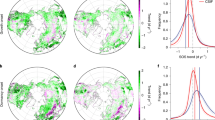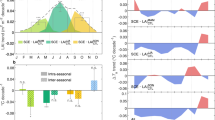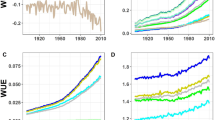Abstract
The carbon balance of terrestrial ecosystems is particularly sensitive to climatic changes in autumn and spring1,2,3,4, with spring and autumn temperatures over northern latitudes having risen by about 1.1 °C and 0.8 °C, respectively, over the past two decades5. A simultaneous greening trend has also been observed, characterized by a longer growing season and greater photosynthetic activity6,7. These observations have led to speculation that spring and autumn warming could enhance carbon sequestration and extend the period of net carbon uptake in the future8. Here we analyse interannual variations in atmospheric carbon dioxide concentration data and ecosystem carbon dioxide fluxes. We find that atmospheric records from the past 20 years show a trend towards an earlier autumn-to-winter carbon dioxide build-up, suggesting a shorter net carbon uptake period. This trend cannot be explained by changes in atmospheric transport alone and, together with the ecosystem flux data, suggest increasing carbon losses in autumn. We use a process-based terrestrial biosphere model and satellite vegetation greenness index observations to investigate further the observed seasonal response of northern ecosystems to autumnal warming. We find that both photosynthesis and respiration increase during autumn warming, but the increase in respiration is greater. In contrast, warming increases photosynthesis more than respiration in spring. Our simulations and observations indicate that northern terrestrial ecosystems may currently lose carbon dioxide in response to autumn warming, with a sensitivity of about 0.2 PgC °C-1, offsetting 90% of the increased carbon dioxide uptake during spring. If future autumn warming occurs at a faster rate than in spring, the ability of northern ecosystems to sequester carbon may be diminished earlier than previously suggested9,10.
This is a preview of subscription content, access via your institution
Access options
Subscribe to this journal
Receive 51 print issues and online access
$199.00 per year
only $3.90 per issue
Buy this article
- Purchase on Springer Link
- Instant access to full article PDF
Prices may be subject to local taxes which are calculated during checkout



Similar content being viewed by others
References
Goulden, M. L. et al. Sensitivity of boreal forest carbon balance to soil thaw. Science 279, 214–217 (1998)
Randerson, J. T., Field, C. B., Fung, I. Y. & Tans, P. P. Increases in early season ecosystem uptake explain recent changes in the seasonal cycle of atmospheric CO2 at high northern latitudes. Geophys. Res. Lett. 26, 2765–2768 (1999)
Morgenstern, K. et al. Sensitivity and uncertainty of the carbon balance of a Pacific Northwest Douglas-fir forest during an El Niño La Niña cycle. Agric. For. Meteorol. 123, 201–219 (2004)
Bergeron, O. et al. Comparison of carbon dioxide fluxes over three boreal black spruce forests in Canada. Glob. Change Biol. 13, 89–107 (2007)
Mitchell, T. D. & Jones, P. D. An improved method of constructing a database of monthly climate observations and associated high-resolution grids. Int. J. Climatol. 25, 693–712 (2005)
Myneni, R. B., Keeling, C. D., Tucker, C. J., Asrar, G. & Nemani, R. R. Increased plant growth in the northern high latitudes from 1981 to 1991. Nature 386, 698–702 (1997)
Zhou, L. M. et al. Variations in northern vegetation activity inferred from satellite data of vegetation index during 1981 to 1999. J. Geophys. Res. 106, 20069–20083 (2001)
Churkina, G., Schimel, D., Braswell, B. H. & Xiao, X. M. Spatial analysis of growing season length control over net ecosystem exchange. Glob. Change Biol. 11, 1777–1787 (2005)
Cramer, W. et al. Global response of terrestrial ecosystem structure and function to CO2 and climate change: results from six dynamic global vegetation models. Glob. Change Biol. 7, 357–373 (2001)
Sitch, S. et al. Evaluation of the terrestrial carbon cycle, future plant geography and climate–carbon cycle feedbacks using 5 Dynamic Global Vegetation Models (DGVMs). Glob. Change Biol. (in the press)
Black, T. A. et al. Increased carbon sequestration by a boreal deciduous forest in years with a warm spring. Geophys. Res. Lett. 27, 1271–1274 (2000)
Tanja, S. et al. Air temperature triggers the recovery of evergreen boreal forest photosynthesis in spring. Glob. Change Biol. 9, 1410–1426 (2003)
Menzel, A. et al. European phenological response to climate change matches the warming pattern. Glob. Change Biol. 12, 1969–1976 (2006)
Schwartz, M. D., Ahas, R. & Aasa, A. Onset of spring starting earlier across the Northern Hemisphere. Glob. Change Biol. 12, 343–351 (2006)
IPCC. Climate Change 2007: The Physical Sciences Basis: Contribution of Working Group I to the Fourth Assessment Report of the Intergovernmental Panel on Climate Change (Cambridge Univ. Press, Cambridge, 2007)
Krinner, G. et al. A dynamic global vegetation model for studies of the coupled atmosphere–biosphere system. Glob. Biogeochem. Cycles 19 doi: 10.1029/2003GB002199 (2005)
Hourdin, F. & Armengaud, A. The use of finite-volume methods for atmospheric advection of trace species. Part I: Test of various formulations in a general circulation model. Mon. Weath. Rev. 127, 822–837 (1999)
Keeling, C. D., Chin, J. F. S. & Whorf, T. P. Increased activity of northern vegetation inferred from atmospheric CO2 measurements. Nature 382, 146–149 (1996)
Heimann, M. et al. Evaluation of terrestrial carbon cycle models through simulations of the seasonal cycle of atmospheric CO2: First results of a model intercomparison study. Glob. Biogeochem. Cycles 12, 1–24 (1998)
GLOBALVIEW-CO2. Cooperative Atmospheric Data Integration Project Carbon Dioxide, 〈ftp://ftp.cmdl.noaa.gov/ccg/co2/GLOBALVIEW〉 (2004)
Angert, A. et al. Drier summers cancel out the CO2 uptake enhancement induced by warmer springs. Proc. Natl Acad. Sci. USA 102, 10823–10827 (2005)
Linderholm, H. W. Growing season changes in the last century. Agric. For. Meteorol. 137, 1–14 (2006)
Ciais, P. et al. Europe-wide reduction in primary productivity caused by the heat and drought in 2003. Nature 437, 529–533 (2005)
Piao, S. L., Friedlingstein, P., Ciais, P., Zhou, L. M. & Chen, A. P. Effect of climate and CO2 changes on the greening of the Northern Hemisphere over the past two decades. Geophys. Res. Lett. 33 doi: 10.1029/2006GL028205 (2006)
Myneni, R. B. & Song, X. NDVI Version 3 based on Pathfinder, 〈ftp://primavera.bu.edu/pub/datasets/AVHRR_DATASETS/PATHFINDER/ VERSION3_DATA/〉 (2003)
Marti, O. et al. The New IPSL Climate System Model: IPSL-CM4 (Institut Pierre Simon Laplace, Paris, 2006)
Thoning, K. W., Tans, P. P. & Komhyr, W. D. Atmospheric carbon-dioxide at Mauna Loa Observatory. 2. Analysis of the NOAA GMCC data, 1974–1985. J. Geophys. Res. 94, 8549–8565 (1989)
Aubinet, M. et al. Estimates of the annual net carbon and water exchange of forest: the EUROFLUX methodology. Adv. Ecol. Res. 30, 113–175 (2000)
Papale, D. et al. Towards a standardized processing of Net Ecosystem Exchange measured with eddy covariance technique: algorithms and uncertainty estimation. Biogeosciences 3, 571–583 (2006)
Richardson, C. W. & Wright, D. A. A Model for Generating Daily Weather Variables, Technical Report (US Department of Agriculture, Agricultural Research Service, Washington DC, 1984)
van Leer, B. Towards the ultimate conservative difference scheme: IV. A new approach to numerical convection. J. Comput. Phys. 23, 276–299 (1977)
Tiedtke, M. A comprehensive mass flux scheme for cumulus parameterization in large-scale models. Mon. Weath. Rev. 117, 1779–1800 (1989)
Takahashi, T. et al. in Extended Abstracts of the 2nd International CO in the Oceans Symposium 18–01 (Tsukuba, Japan, 1999)
Marland, G., Boden, T. A. & Andres, R. J. Global, Regional, and National CO2 Emissions. Trends: A Compendium of Data on Global Change.. 〈http://cdiac.esd.ornl.gov/trends/emis/tre_glob.htm〉 (2007)
Gurney, K. R. et al. Sensitivity of atmospheric CO2 inversions to seasonal and interannual variations in fossil fuel emissions. J. Geophys. Res. 110 doi: 10.1029/2004JD005373 (2005)
Acknowledgements
We thank all the people and their respective funding agencies who worked to provide data for this study, and specifically B. Amiro, M. A. Arain, T. A. Black, C. Bourque, L. Flanagan, J. H. McCaughey and S. Wofsy for providing some of the flux data from the Canadian sites, and M.-A. Giasson and C. Coursolle for their help in compiling the data. We also thank A. Friend, P. Rayner and N. Viovy for helpful comments and discussions. This study was supported by European Community-funded projects ENSEMBLES and CARBOEUROPE IP, and by the National Natural Science Foundation of China as well as by Fluxnet-Canada, which was supported by CFCAS, NSERC, BIOCAP, MSC and NRCan. The computer time was provided by CEA. We thank the NOAA-ERSL global air sampling program for collecting and analysing the long-term CO2 flask data, and K. Masarie at NOAA-ERSL for generating each year the GLOBALVIEW-CO2 collaborative data product, which formed the basis of our atmospheric data analysis. The ongoing exchange of ideas, data and model results in the international research community on the carbon cycle is facilitated by the Global Carbon Project.
Author Contributions P.C., S.P., P.F. and P.P. designed the research. S.P., P.C. and P.F. performed ORCHIDEE modelling analysis. P.P. and S.P. performed transport analysis. S.P., S.L., M.R., H.M. and P.C. performed eddy-covariance data analysis. S.P., P.C. and J.F. performed satellite data analysis. All authors contributed to the interpretation and writing.
Author information
Authors and Affiliations
Corresponding authors
Supplementary information
Supplementary Information
The file contains Supplementary Notes, Supplementary Tables S1-S4 and a Supplementary Figure S1 with Legend. (PDF 378 kb)
Rights and permissions
About this article
Cite this article
Piao, S., Ciais, P., Friedlingstein, P. et al. Net carbon dioxide losses of northern ecosystems in response to autumn warming. Nature 451, 49–52 (2008). https://doi.org/10.1038/nature06444
Received:
Accepted:
Issue Date:
DOI: https://doi.org/10.1038/nature06444
This article is cited by
-
Spatiotemporal patterns of net regional productivity and its causes throughout Ordos, China
Environmental Science and Pollution Research (2024)
-
Looking for a drought-tolerant tree species among native and introduced mountain conifers
Trees (2024)
-
A path analysis approach to model the gross primary productivity of mangroves using climate data and optical indices
Modeling Earth Systems and Environment (2024)
-
Exploring grazing intensity effects: nitrogen uptake in grassland species and soil carbon allocation
Plant and Soil (2024)
-
Construction and assessment of an indicator system of stream conditions in a typical mountain landscape in Northeast China
Environmental Science and Pollution Research (2024)
Comments
By submitting a comment you agree to abide by our Terms and Community Guidelines. If you find something abusive or that does not comply with our terms or guidelines please flag it as inappropriate.



